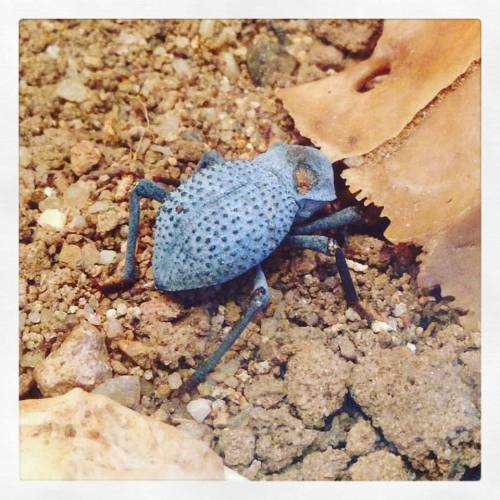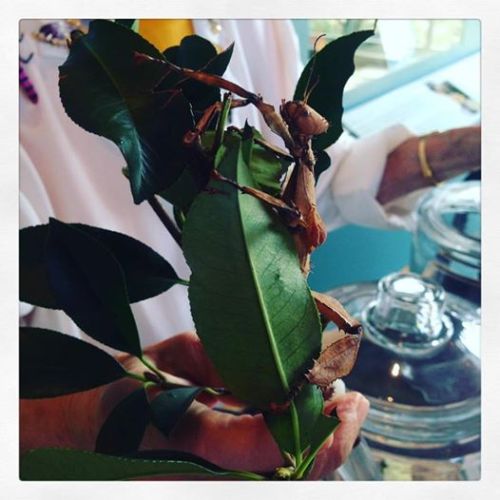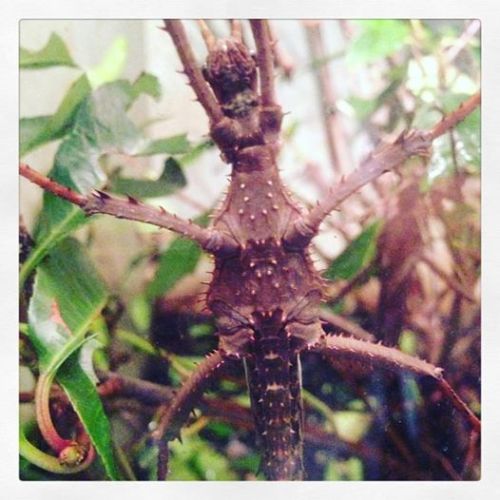#1143-1148 - Stuff Purrdence Saw
#1143 - Asbolus verrucosus - Blue Death-feigning Beetle

Purrdence was in Washington DC this week, and among the places she visited was the O. Orkin Insect Zoo at the Smithsonian Museum of Natural History. Naturally, she posted a bunch of photos to see If I could recognise them. It helps that people like @speciesofleastconcern and a good fifth of the other blogs I follow post North American insects.
This large beetle was an Ironclad Beetle, if I recalled correctly, but checking ruled out the Zopheridae, the very robust beetles usually called iron-clads. So I fell back to my other suspicion, a desert-dwelling Darkling Beetle. That time, I was right - Asbolus verrucosus is native to Sonoran Desert and other parts of the US SW, but has become quite popular in the pet trade for their robustness, longevity, and ease of care. The common name comes from their habit of playing dead if disturbed, and the blue pruinescense is a water-proofing wax.
#1144 - Extatosoma tiaratum - Macleay’s Spectre


AKA Spiny Stick Insect, giant prickly stick insect, spiny leaf insect, or Australian walking stick.
A very large and placid Australian species, that has also found a role as a pet and exhibit worldwide. In the wild it eats eucalypts, but in captivity overseas they’ll eat bayberry, bramble, hawthorn, oak, photinia, raspberry, rose, and salmon berry. I don’t know that have it on in the photo - it’s certainly not a eucalypt.
The eggs are flung away from the parent with some speed, and are coated in fats and oils that make them irresistible to ants. The ants carry the seed-like eggs back into their nests, eat the fats and oils, and dump the egg on their refuse pile, where the stick insect can develop in peace, away from the heat, parasites, and predators.
The infant stick insect strongly resemble a spider ant (Leptomyrmex) including in colour, and holding their abdomens up over their body. This protects them as they run for the nearest eucalypt.
Photos by @purrdence, at the O. Orkin Insect Zoo at the Smithsonian.
#1145 - Gromphadorhina sp. - Madagascan Hissing Roach

Another popular insect in the pet trade, so not entirely surprising that @purrdence got to hold one at the Smithsonian’s insect zoo. There’s at least 20 species in the genus, living inside rotten logs in Madagascar, and traders are frequently unaware or don’t care what species they’re selling.
Hissers can expel air from their spiracles, and have three different calls that can produce by this method - the disturbance hiss, the female-attracting hiss, and the aggressive fighting hiss (used for intimidating rival males). The female will hold the ootheca inside her body until after her children have hatched, and they’ll stay with the mother for a good while. In captivity, they can live for up to 5 years.
They’ve also been used in a number of movies, including Team America, Bug, (where they start fires ), and Damnation Alley (go man-eating mutant roaches, go!). Unfortunately they’ve also been subject to serious abuse, as in Starship Troopersand by the Six Flags amusement park that challenged patrons to eat them alive. Hissers are mildly poisonous. Sadly, not poisonous enough.
#1146 - Dolichovespula maculata - Bald-faced Hornet

AKA bald hornet, white-faced hornet, white-tailed hornet, blackjacket, andbull wasp. Social wasps in the family Vespidae.
@purrdence found this one in front of the IRS in Washington DC. I’m sure somebody can construct a witticism from that coincidence.
These yellowjackets are most common in the south-east of North America, but is found over much of the continent, collecting huge numbers of insects are other invertebrates to feed their young. They build hanging paper nests which they will defend aggressively - the stings are intensely painful at first, but fade entirely within a few hours.
Social structure in the nest can be disrupted by the worker’s impetus to lay unfertilized eggs, which will become drones and hopefully go on to father nests of their own. The queen, of course, wants to ensure that all the drones are her sons. And if everybody is producing sons the colony will starve anyway. It seems to balance out at around 20% - one-fifth of the drones in a nest are worker-born males.
Fertilized queens will overwinter, and start new nests in spring, while all her brothers and older sisters die off in the middle of autumn.
#1147 - Bondarzewia berkeleyi - Butt Rot Polypore

ID by @speciesofleastconcern - A fungus @purrdence spotted on the Netherlands part of her trip. Formerly Polyporus berkeleyi, also known as Berkeley’s polypore, or stump blossoms.
This fungus, which despite appearances is actually in the same family as the gilled Russulas, grows on or near the base of oaks and other hardwoods. It’s parasitic, causing the plant disease Butt Rot. The polypore parts themselves are edible, but tasteless and tough, or somewhat bitter and tough in older specimens.
#1148 - Deroceras sp. - Field Slug

Seems closest to Deroceras agreste, formerly Agriolimax agrestis, aka grey field slug, milky slug, and northern field slug. They’re more often grey or oatmeal coloured, but tan and buff individuals aren’t rare. Dissection would be needed to confirm the ID. Most of the Agriolimacid slugs get rolled back into one genus - Deroceras - in 2000, because the taxonomy was that much of a mess.
If attacked, Deroceras agreste slugs produce a white mucus in self-defense. They live in moist fields and marshy areas, and may become a pest of lettuce. Native to Asia, and Northern and central Europe..
@purrdence saw this one in Overloon, in the Netherlands.